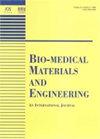应变超声弹性成像评估膝关节副韧带刚度
IF 1
4区 医学
Q4 ENGINEERING, BIOMEDICAL
引用次数: 2
摘要
背景:了解正常副韧带的生物力学对于确保损伤后膝关节的最佳稳定性非常重要。在评估这些韧带的生物力学方面,已经描述了各种体外方法。然而,尚无直接评价方法的报道。目的:利用应变超声弹性成像技术确定膝关节副韧带的刚度特征。方法:对18例健康男性(36条韧带)膝关节不同屈曲角度侧副韧带的不同组成进行应变超声弹性成像。我们使用应变比(SR =目标组织应变/参考应变)测量韧带的相对刚度。应变比越小,相对刚度越高。结果:在所有韧带部分的应变比测量中,有中等到优异的内部和内部一致性。所有三根韧带在0°时应变比最低,表明相对刚度高。在浅、深内侧副韧带中,应变比随膝关节屈曲的增加而增加,而在外侧副韧带中,刚度呈波动趋势。结论:应变超声弹性成像是监测膝关节副韧带相对刚度的可靠工具,易于应用于常规临床。本文章由计算机程序翻译,如有差异,请以英文原文为准。
Assessment of knee collateral ligament stiffness by strain ultrasound elastography
BACKGROUND: Knowledge of the biomechanics of the normal collateral ligaments is important to secure optimal stability of the knee following injury. Various in vitro methods have been described in evaluating the biomechanics of these ligaments. However, a method of direct evaluation has not been reported. OBJECTIVE: To determine the stiffness characteristics of the collateral ligaments of the knee using strain ultrasound elastography. METHODS: Strain ultrasound elastography was performed on different components of the collateral ligaments in various angles of knee flexion in 18 healthy males (36 ligaments). We measured relative stiffness of the ligaments using strain ratio (SR = target tissue strain/reference strain). A lower strain ratio indicates higher relative stiffness. RESULTS: There was moderate to excellent intra- and inter-rater agreement for strain ratio measurements in all ligament portions. Strain ratios were lowest at 0° in all three ligaments, indicating high relative stiffness. In the superficial and deep medial collateral ligaments, the strain ratio increased with increasing knee flexion, whereas in the lateral collateral ligament, stiffness showed a tendency to fluctuate. CONCLUSION: Strain ultrasound elastography is a reliable tool for monitoring relative stiffness of the collateral ligaments of the knee and is easily applied to the routine clinical setting.
求助全文
通过发布文献求助,成功后即可免费获取论文全文。
去求助
来源期刊

Bio-medical materials and engineering
工程技术-材料科学:生物材料
CiteScore
1.80
自引率
0.00%
发文量
73
审稿时长
6 months
期刊介绍:
The aim of Bio-Medical Materials and Engineering is to promote the welfare of humans and to help them keep healthy. This international journal is an interdisciplinary journal that publishes original research papers, review articles and brief notes on materials and engineering for biological and medical systems. Articles in this peer-reviewed journal cover a wide range of topics, including, but not limited to: Engineering as applied to improving diagnosis, therapy, and prevention of disease and injury, and better substitutes for damaged or disabled human organs; Studies of biomaterial interactions with the human body, bio-compatibility, interfacial and interaction problems; Biomechanical behavior under biological and/or medical conditions; Mechanical and biological properties of membrane biomaterials; Cellular and tissue engineering, physiological, biophysical, biochemical bioengineering aspects; Implant failure fields and degradation of implants. Biomimetics engineering and materials including system analysis as supporter for aged people and as rehabilitation; Bioengineering and materials technology as applied to the decontamination against environmental problems; Biosensors, bioreactors, bioprocess instrumentation and control system; Application to food engineering; Standardization problems on biomaterials and related products; Assessment of reliability and safety of biomedical materials and man-machine systems; and Product liability of biomaterials and related products.
 求助内容:
求助内容: 应助结果提醒方式:
应助结果提醒方式:


